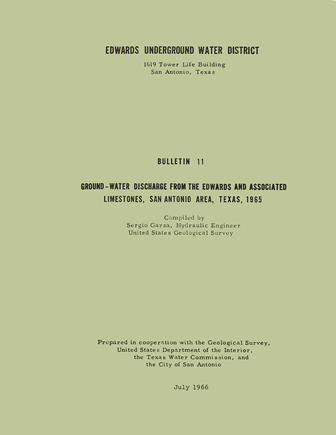Ground-Water Discharge from the Edwards and Associated Limestones, San Antonio Area, Texas, 1965

| Author | Garza S (US Geological Survey) |
| Year | 1966 |
| Description | Annual report for 1965 on discharge from the Edwards Aquifer issued by the Edwards Underground Water District |
| Report Number | Bulletin 11 |
| Publisher | Edwards Underground Water District |
| Location | Edwards Aquifer Balcones Fault Zone San Antonio Segment |
| Cover | View Download |
| File | View Download |
| Summary |
|
Records of the ground-water discharge from the Edwards and associated limestones in the San Antonio area are collected as part of the overall hydrologic investigation of the u. S. Geological Survey in cooperation with the Edwards Underground Water District, the Texas Water Commission , and the city of San Antonio. This investigation has been continued for many years and has resulted in several geologic and hydrologic reports, some of which are listed in the references. This report is one of three basic- data reports published yearly by the Edwards Underground Water District. The table included in this report represents the discharge from the Edwards and associated limestones during 1965 in each county of the area by use. The spring discharge was from San Marcos Springs in Hays County, Comal Springs in Comal County, San Antonio and San Pedro Springs in Bexar County, and the Leona River Springs in Uvalde County. Most of the discharge by wells was in Bexar, Uvalde, and Medina Counties. Wells in Bexar County supplied most of the water for municipal and military use, the largest single use in the San Antonio area. Other wells in Bexar County and most of the large wells in Uvalde and Medina Counties supplied the irrigation needs of nearly 44,000 acres in this combined area . The remaining discharge, principally from wells in Bexar County, was for industrial, domestic, stock, and miscellaneous purposes. The discharge by wells in 1965 amounted to 44 percent of the total discharge, which exceeded the 1964 total discharge by more than 100,000 acre-feet. The discharge by wells for both years was approximately the same; therefore, all the increase during 1965 was due to increased flow from the springs. |
Search for Documents
Advance Search
Explore EAA's Scientific Reports
- All Reports
- Water Use and Conservation
- Geochemistry
- Water Resources Planning and Management
- Floods and Drought
- Water Quality
- Climatology
- Surface Water / Groundwater Relationship
- Biology
- Springs, Groundwater Discharge
- Archaeology
- RZ Protection
- Aquifer Levels
- Remote Sensing
- Precipitation
- Overview Studies
- Modeling
- Hydrology and Hydrogeology
- History
- Groundwater Recharge, Recharge Zone
- Groundwater Movement
- Geomorphology and Caves
- Weather Modification
- Geology
